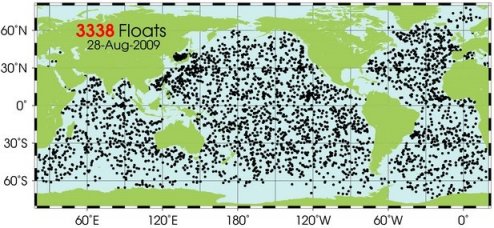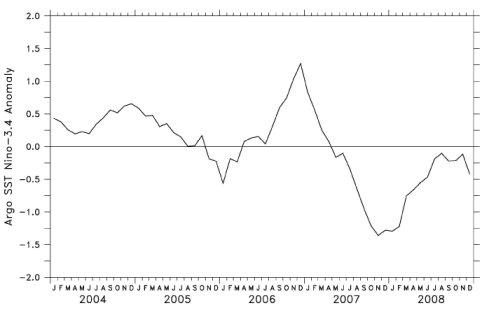Argo is the name given to an array of over 3,000 buoys that have been installed throughout the word’s oceans. It is a tribute to how countries can work together toward a common goal, as it is the result of a collaboration among more than 50 scientific institutions in 26 different countries. Of course, as is typical, while the United States is only one of those 26 countries, it contributes over half of the money necessary to fund this ambitious project. As you can see from the image below, the buoys do a good job of covering the majority of earth’s oceans 1:

What do these buoys do? Well, periodically, they dive 3,000 feet into the ocean and, as they rise back up, they measure things about the ocean water, like salt content, pressure, and…oh yeah…temperature. They’ve been measuring these things since 2003, and the scientific community really wanted to start seeing how these measured quantities have changed over the years. Now that they have seen the results, many scientists are shutting their eyes, covering their ears, and yelling as loudly as they can, because the data go squarely against the concept of “Global Warming.”
You see, despite the best hopes and prayers of many in the global-warming alarmist community, the change in ocean temperature since 2003 has been essentially the same as the change in global temperature over the same time period: both the globe and the oceans have been cooling. You can see the latest satellite measurements of global temperature by going here:
Global Mid-Tropospheric Temperatures Since 1979
You can see two things from this graph. First, the temperature (the jagged line in the graph) of the troposphere (that’s the part of the atmosphere where the weather occurs) has not changed in any systematic way since 1979 despite the fact that the carbon dioxide levels (the wavy line) have systematically increased. Thus, while carbon dioxide levels have risen, the globe has neither cooled nor warmed overall in the past 30 years. If you look at the temperature in the graph from 2003 on, however, you will see a clear trend – the troposphere has been cooling since 2003. This is mostly like in response to the fact that the late 1990s were abnormally warm.
Now, of course, all global-warming alarmists know these data. In fact, they used to be published on NASA’s own website, but when too many people started pointing to NASA’s website as evidence that “global warming” is not happening, NASA quickly removed the data.
So if global-warming alarmists know that the most accurate measure of global temperatures shows no systematic change in global temperature over the past 30 years, how do they maintain their fervent faith in “global warming?” One way that some cope is to pray that the ocean is taking the excess heat generated by global warming. Some estimates indicate that as much as 80% of the earth’s heat is held in the oceans, so some global-warming alarmists were putting their faith into the idea that the temperature of the atmosphere is a “lagging indicator” of “global warming,” because the ocean is stealing all of the excess heat stored in…uh….the atmosphere’s extra carbon dioxide. Of course, no one has ever proposed even the most vague mechanism by which heat that is caught in the atmosphere gets transferred to the ocean before we can measure it in the atmosphere. But hey…when you REALLY want to believe in something, pesky details like science don’t matter!
These global-warming alarmists will now have to come up with some other excuse for why the data don’t show any long-term global warming trends, because the Argo system has shown that just like the atmosphere, the oceans have been cooling since 2003. Here is a graph of the Argo data 2 covering the “Nino 3.4 Region” of the world’s oceans, which is essentially from latitudes 5N – 5S and longitudes 120W – 170W:

Notice that you see the same trend in the ocean data as you see in the atmospheric data: the oceans have been cooling since 2003.
So what’s a global-warming alarmist to do? Well, Josh Willis at NASA’s Jet Propulsion Laboratory simply discounts the data. Despite the fact that he says the oceans are what really matter when it comes to global warming, he also says:
There has been a very slight cooling, but not anything really significant…Global warming doesn’t mean every year will be warmer than the last. And it may be that we are in a period of less rapid warming. 3
In other words, Willis says, “Don’t look at the data – listen to me. I say global warming is happening (because that’s what NASA tells me to say), so it doesn’t matter that the data say otherwise.”
Is it any wonder that responsible scientists have been defecting from the “global warming” bandwagon? 4
REFERENCES
1. The Argo Home Page at UC San Diego
Return to Text
2. The Argo Data Page at UC San Diego
Return to Text
3. The Mystery of Global Warming’s Missing Heat by NPR’s Richard Harris
Return to Text
4. I Was On the Global Warming Gravy Train by Dr. David Evans
Return to Text

It seems to me if we want to be concerned about something, it should just be the overall increase in carbon dioxide in the air. As usual, this opinion is backed only by my thoughts and the way I see the world, and not on science at all. But it seems to me that breathing in more carbon dioxide would be bad… regardless of temperature.
In essence, you are correct, but there is an issue of cost and benefit that must be considered. First, we know that the point at which carbon dioxide becomes toxic to mammals like mice and so forth is about SIX TIMES what it is in the atmosphere right now. Since carbon dioxide levels have only risen 20% since 1958, the chance of getting to toxic levels seems marginal at best.
Second, based on air bubbles trapped in sedimentary rock and ice, we know that carbon dioxide levels in the distant past were much higher – on the order of FOUR TIMES what they are right now. Thus, the earth survived periods with more carbon dioxide.
So…given the fact that the levels aren’t anywhere near toxic nor are they anywhere near what happened in the distant past, what cost are you willing to bear to get the carbon dioxide levels down to where they were 10 years, 50 years, or 100 years ago? I am not talking about dollar cost so much as cost in terms of human life.
Anything that makes energy more expensive kills people. If heat or air conditioning costs too much, the poor and elderly turn it off and die of exposure. Also, to reduce carbon dioxide emissions now, we will have to limit the development of places like Africa, and the LEADING cause of premature death in the world is to be born in an undeveloped country.